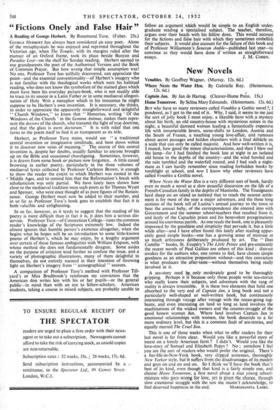New Novels
Venables. By Geoffrey Wagner. (Murray. 12s. 6d.) - Where Nests the Water Hen. By Gabrielle Roy. (Heinemann.
12s. 6d.) BUT why have so many reviewers called Venables a Gothic novel ?, I pondered, as I got to the end of it. Why, I said, it seems to me just the sort of jolly book I most enjoy, a likeable hero with a mystery about his birth, an old country-house with mysterious noises in the night, a beautiful damned woman leading a fantastically expensive life with innumerable lovers, scene-shifts to London, Austria and the South of France, a touching young love-affair, and rumours about secret passages and hidden chambers with a final debacle on a scale that can only be called majestic. And how well-written it is I mused, how good the minor characterisations, and then I blew oui the lamp—for I had finished the book late at night in an isolated old house in the depths of the country—and the wind howled and the rain tumbled and the waterfall roared, and I had such a night- mare as I can hardly remember since reading forbidden books by torchlight .at school, and now I know why other reviewers have called Venables a Gothic novel. - Where Nests the Water Hen is a very different sort of book, hardly even so much a novel as a slow peaceful discursion on the life of a French-Canadian family in the depths of Manitoba. The Tousignants herd sheep on an island so isolated that to reach the nearest settle- ment is for most of the year a major adventure, and the three long sections of the book tell of Luzina's annual journey to the town to bear the annual baby, of the correspondence she entered into with Goverment and the summer school-teachers that resulted from it, and lastly of the Capuchin priest and his benevolent peregrinations around his enormous parish. As one reads the book, one is pleasantly impressed by the goOdness and simplicity that pervade it, but a little while after—and I have ofteti found this lately after reading appar- ently good simple books—one has a growing sense of mistrust at so much artlessness deliberately produced by art. The " Don Camillo " books, St. Exupery's The Little Prince and pre-eminently the recent novels of Paul Gallico are others of this -kind ; distrust awakes for the authors who, one comes to feel, have chosen simple goodness as an attractive proposition without—and this conviction is what produces the after-taste—without themselves being really involved in it.
A sea-story need >y moderately good to be thoroughly gripping. Perhaps it is ' use only those people write sea-stories who really know their subjects, and adventure with the tang of reality is always irresistible. It is these two elements that hold one absorbed to the very end of Captain Jan, a long book and not a particularly well-shaped or well-written book, but continuously interesting through voyage after voyage with the ocean-going tug- boats, and even interesting on land so long as land involves the machinations of the wicked owners and the counter-struggle of the good honest seaman Jan. Where land involves Captain Jan in emotional relationships with women, the book descends to a far more ordinary level, but this is a common fault of sea-stories, and equally marred The Cruel Sea.
This is one of those weeks when what to offer readers for their last novel is far from clear. Would you like a powerful story of incest on a lonely American farm ? I didn't. Would you like the love-story of Samuel and Elizabeth Pepys ? No ; somehoW I feel you are the sort of readers .who would prefer the original. There's a bar-life-in-New-York book, very clipped sentences, 'thoroughly New Yorker style, butit Suffers from the disadvantages of its models and goes On and on and on. So I think we'll have the book that's best of its kind, even though that kind is a fairly simple one, and choose Home Tomorrow, a first novel about a nice young school- mistress who goes wrons for love, yet is given the chance, through slow emotional struggle with the son she mustn't acknowledge, to find deserved happiness in the end. MARGHANITA LASKI;


































 Previous page
Previous page